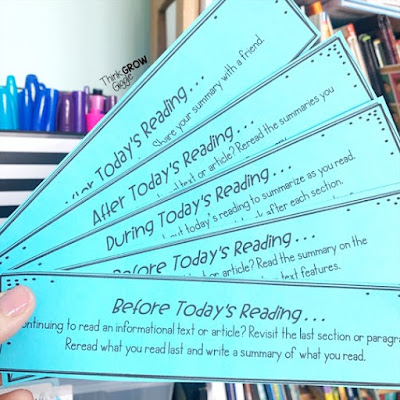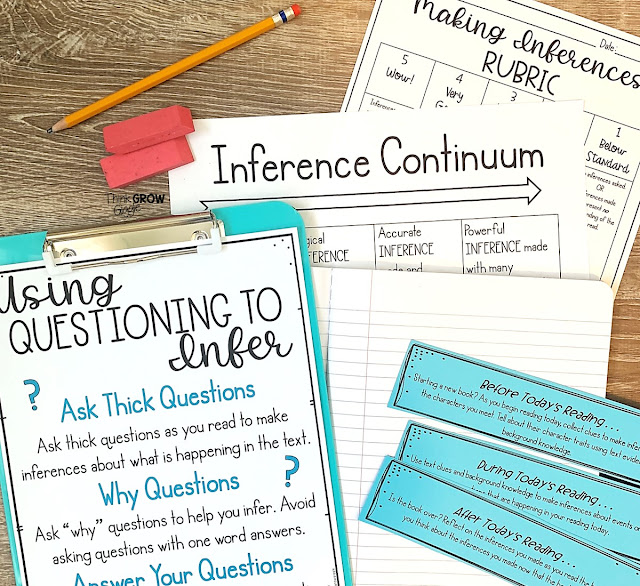3 Nonfiction Pieces Summary Teaching Chess Community Service You and Feeding Frenzy

One sign of strong comprehension skills in students is the ability to summarize what was read using their own words. This reading comprehension strategy is one of the hardest to teach students, especially when it comes to nonfiction summaries. Often times students want to just write fact after fact after fact and call it a summary. While paying attention to facts found in nonfiction text is important, it is not the basis for writing nonfiction summaries.
Before jumping into summarizing nonfiction there are a few lessons that I teach prior to writing nonfiction summaries. Read on to see how I teach nonfiction summarizing in my classroom, breaking it down into different lessons that help students understand how to summarize informational text.
Grab the FREE nonfiction summary resources below. Then read the tips below to help you successfully teach your students how to summarize any nonfiction passage, book, or article they read.

1. Distinguish Interesting VS. Important

Interesting VS Important lessons truly help students avoid writing just a list of facts and calling it a summary.
My students always benefit from lessons on distinguishing the difference between interesting and important information. This is critical when they are writing nonfiction summaries.
Begin by simply discussing the difference between what makes something interesting in the books that they read and what makes something important.
Here is how I explain the difference:
Interesting: Something new that I did not know that piqued my curiosity.
Important: Something that I read that supports the main idea of the reading.
I go one step further to call students' attention to the N in interesting. That helps us remember that interesting is usually something New to us. Looking at the word important, I call attention to the M. That reminds us that it supports the Main idea. This simple trick makes a huge impact on students' understanding of interesting and important.
A great book to use for a lesson on determining importance isHenry's Freedom Box by Ellen Levine. As we read, we chart information into an Interesting vs Important Tchart. This book and activity helps students distinguish the difference, and improve their summary writing as they focus on only the important information.
2. Connect Summarizing with Main Idea...Start with Oral Summaries

The best way for students to understand what to summarize when it comes to nonfiction texts is to connect it to their understanding of finding the main idea. We begin discussing summarizing by simply practicing oral summaries. Since we have already had several lessons on main idea and supporting detail it is an easy way for students to pull out the important parts of the informational text to include in their oral summary.
When teaching fiction summary writing, one strategy that I use is the SWBSA frame. You can read about that HERE. Since my students love this frame and strategy I wanted to offer them a similar frame and strategy for nonfiction summary writing. That is why I came up with the idea and organizer for a concept I call TSMIDS.
TSMIDS simply stands fortopic sentence, main idea, and details that support.
I use this frame to show students how to write a quick summary. This is a good format to use when students are discussing sections of a nonfiction book or article. This is also perfect for students to summarize what is going on within their book when you meet with them for reader's workshop group time and conferencing. Once students master this format, I expect them to add more to their summaries.
3. Model Summary Writing with Mentor Texts

When introducing summaries, I like to use informational books or articles that we previously read. I model summary writing with a book that we have already read in class or even informational magazines like Time for Kids. Since we read the Moon Book during our science unit it is a great one for us to revisit as readers who are writing summaries.
Teacher tip: Be sure to grab the free resources above to grab the modeled example for a nonfiction summary using the Moon Book.
Once I have modeled my expectations, we write a few nonfiction summaries together, again using books that we have already read as a class. I like to use books and articles that we have already read because I know students already understand the main idea in the books that we have read and discussed as a class. This allows them to focus on writing a summary with important information, rather than reading the book for understanding.
Informational texts and authors that I like to use that have been previously read include:
- Time For Kids magazine (also online articles from TFK)
- Anything written by Gail Gibbons or Seymour Simon
- National Geographic Book Series
- Rookie Readers
- I Can Read (highest level readers)
- Let's Read and Find Out Series
Just go to your bookshelf and find an informational book that you have already read with the class and start from there! Even better if it is a book that you read during a science, health, or social studies lesson.
4. Practice, Practice, Practice

Now that you have taught students everything from determining importance to the TSMIDS strategy, students are ready to head off and practice summarizing nonfiction texts.
The key here is to have them practice, practice, practice. You can have them practice in isolation by using task cards and short passages. Another great way to practice is to have students summarize each section under one heading within a nonfiction passage.
An engaging way that I like to have students practice summaries of informational text is to use my mid-workshop break. When our break comes, I have students meet up with their reading partners and share an oral summary of what was read. Remember that students should practice BOTH summarizing orally and summarizing in writing. The more they share summaries in oral form, the better their written summaries will be.
Summarizing nonfiction does not have to be difficult for you to teach or for your students to grasp. The more specific your instruction is the easier it will be for students to summarize. Once they get the hang of it, don't stop. Have them practice, practice, and practice some more!
You might be interested in reading:
Looking for more reading activities that will make a big impact in your classroom? Click the HERE.

LOVE these tips? Pin to save!

*affiliate links: "Think Grow Giggle is a participant in the Amazon Services LLC Associates Program, an affiliate advertising program designed to provide a means for sites to earn advertising fees by advertising and linking to Amazon." (source: Section 5)
Source: http://www.thinkgrowgiggle.com/2022/01/strategies-for-teaching-nonfiction.html
0 Response to "3 Nonfiction Pieces Summary Teaching Chess Community Service You and Feeding Frenzy"
Post a Comment